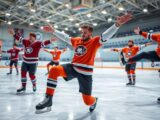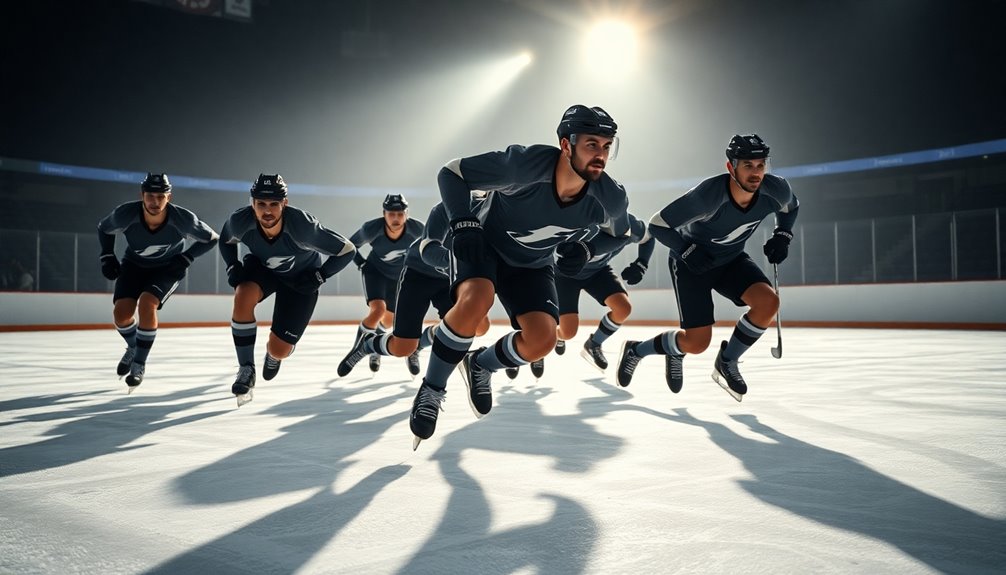
How Hockey Players Build Stronger Legs for Speed and Power
December 19, 2024To build stronger legs for speed and power in hockey, you'll focus on key exercises like squats, deadlifts, and lunges. These workouts should happen 2-3 times a week, allowing for maximum strength gains. Incorporating plyometric training, such as box jumps, helps improve explosive power essential for skating. Don't forget agility drills; they enhance your footwork and coordination for quick directional changes. Adding active recovery, proper nutrition, and sleep will further support your progress. If you stick around, you'll discover more strategies that can elevate your game on the ice.
Importance of Leg Strength
Leg strength is absolutely fundamental for hockey players, as it directly impacts your skating speed, agility, and overall performance on the ice. Strong quadriceps, hamstrings, and glutes are essential for generating the explosive power you need to accelerate quickly, change direction, and shoot with precision. Incorporating speed training helps to enhance acceleration and quickness, which are vital for on-ice performance. Additionally, cardiovascular endurance is crucial for sustaining energy levels throughout intense gameplay.
When you focus on developing your leg strength, you're not just enhancing your skating; you're also increasing your scoring potential. Multi-joint movements in your training for hockey, such as squats and lunges, are crucial for building the strength needed to maximize your performance. These exercises engage multiple muscle groups, leading to greater overall power. Improved leg strength translates to more goals and points during games, showcasing the direct correlation between your physical fitness and on-ice success. Additionally, incorporating endurance training methods into your regimen will further enhance your stamina for high-intensity gameplay.
To truly harness the benefits of leg strength, consistent training is key. Aim to incorporate leg workouts 2-3 times a week to guarantee you're making steady gains throughout the hockey season.
Frequency of Leg Training
To build stronger legs, you need to train them 2-3 times a week for the best results. This frequency not only boosts your strength but also helps you recover better, keeping soreness at bay. Just like honing your skills on the ice, consistent leg workouts are vital for enhancing your overall performance. Incorporating targeted leg strength workouts into your routine can significantly improve your explosive power and overall athleticism. Additionally, focusing on endurance building workouts can enhance stamina, allowing for sustained performance during games. Implementing dynamic warm-up routines before leg workouts can further prevent injuries and improve performance.
Optimal Training Frequency
When it comes to building leg strength, training frequency plays an essential role in your overall performance. Training your legs only once a week isn't enough to make significant gains. Instead, aim for a peak training frequency of 2-3 times per week. This consistent approach not only enhances your leg strength but also leads to improved performance on the ice.
By engaging in regular workouts, you allow your body to adapt and recover effectively, which helps prevent excessive soreness from overloading in a single session. A well-structured training program should incorporate a variety of exercises and progressive overload, which can be achieved more effectively with 2-3 sessions weekly.
Just like honing your hockey skills, leg strength training benefits from frequent practice.
Structured off-ice programs targeting leg strength and power are designed for consistency and should ideally span over 60 weeks. This long-term commitment guarantees ongoing improvement and development in your leg strength.
Recovery and Performance Balance
Balancing recovery and performance is essential for hockey players looking to enhance their leg strength. To achieve ideal results, you should train your lower body 2-3 times a week. This frequency not only boosts strength gains but also allows your muscles to recover effectively, which is vital for maintaining peak performance.
Here's what you need to keep in mind:
- Frequent Training: Strength training sessions should occur multiple times weekly to develop leg power and speed.
- Prevent Soreness: Consistent leg workouts help mitigate the excessive soreness that can stem from overloading muscles in a single session.
- Structured Programs: Engage in off-ice programs that span at least 60 weeks to build a solid foundation for strength and power.
- Skill Development: Prioritize leg strength as much as you do your hockey skills; both are key to your success on the ice.
- Recovery Focus: Allow adequate time for muscle repair and growth, which enhances your overall on-ice capabilities.
Key Leg Exercises
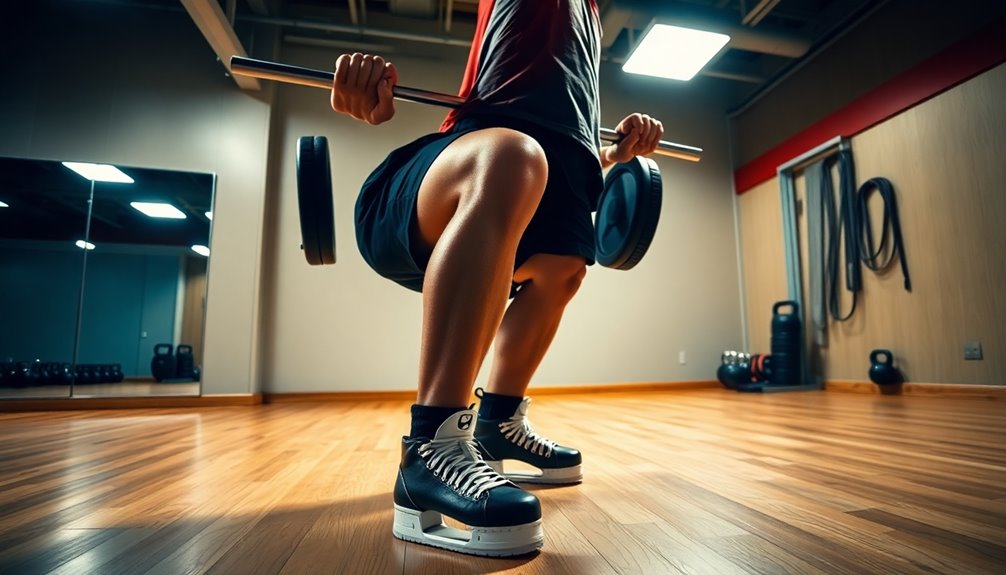
Building stronger legs is essential for hockey players, and incorporating key leg exercises can make a significant difference in performance on the ice. To enhance your strength and speed, you should focus on a variety of leg workouts for hockey that target all the major muscle groups.
Start with squats, which are fundamental for building overall strength and power, important for explosive skating movements. Deadlifts are another essential exercise, emphasizing your posterior chain to boost power generation for effective skating strides. Additionally, developing a strong aerobic base through cardio training can further support your leg strength and endurance. Racial integration in sports has shown that diverse athletic representation can inspire athletes to push their limits and enhance performance.
Don't overlook lunges, including variations like reverse and walking lunges, as they help improve unilateral strength and balance—crucial for quick directional changes on the ice.
Plyometric exercises, such as box jumps and squat jumps, also play a significant role in developing explosive leg power and speed, allowing you to accelerate rapidly during games.
Finally, consider incorporating trap bar deadlifts into your routine; they effectively target key muscle groups while mimicking the functional movements used in skating. Additionally, incorporating interval training can further enhance your cardiovascular endurance, which is crucial for sustained performance on the ice.
Sample Hockey Leg Workout
A sample hockey leg workout can greatly enhance your strength and performance on the ice. This routine focuses on multi-joint movements that build power and stability, essential for any hockey player.
Here's a workout you can incorporate into your training:
- Trap Bar Deadlift: 3 sets of 5 reps to target overall strength.
- Dumbbell Reverse Lunge: 3 sets of 6 reps for developing quads and hamstrings.
- Valslide Leg Curls: 3 sets of 6 reps to strengthen those important hamstrings.
- Med Ball Adductor Squeeze: 3 sets of 6 reps to improve inner thigh strength and prevent groin strains.
- 1/2 Kneeling Cable Lift & Punch: 3 sets of 6 reps to engage your core and obliques. This approach can also enhance cardiovascular endurance during high-intensity activities. Additionally, focusing on mental resilience can help athletes push through challenging workouts.
Incorporating dynamic stretches before this workout can help prevent injuries and improve flexibility during your leg training.
Agility and Coordination Drills
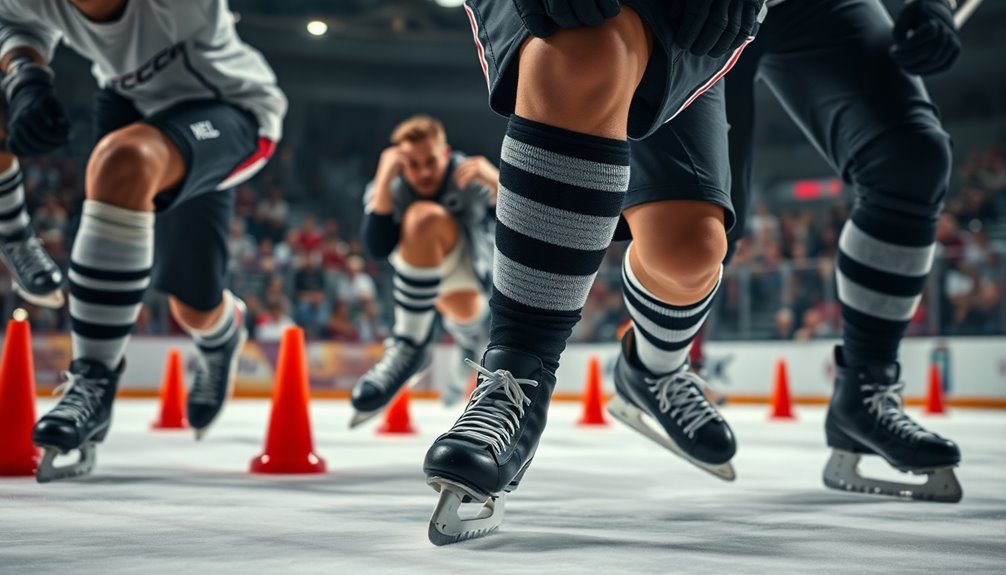
To elevate your performance on the ice, incorporating agility drills into your training is essential. These exercises not only boost your footwork but also enhance coordination, allowing for quicker directional changes during gameplay. Additionally, focusing on team coordination during these drills can significantly improve your overall effectiveness on the ice. Engaging in agility drills can also sharpen your speed and explosive power, which are crucial for dominating on the ice. Moreover, mastering anticipation skills can further enhance your ability to react quickly during fast-paced gameplay.
Key Agility Drills
Agility drills play an important role in developing the quick footwork and coordination necessary for hockey players.
These exercises help you improve your agility, lateral strength, and overall balance and stability, making quick directional changes on the ice easier.
Here are some key drills to incorporate into your training:
- Agility ladder drills: Perform in-and-out or lateral shuffle patterns to enhance footwork and coordination.
- Russian step-ups: Target your quadriceps and glutes while challenging your balance and stability, simulating skating movements.
- Kettlebell swings: Engage your posterior chain for explosive hip extension, essential for powerful skating strides.
- Resistance band exercises: Include lateral band walks and hip abductions to boost lateral strength and maintain balance during fast-paced play.
- Slide board workouts: Develop lateral strength and balance by mimicking the skating motion, important for effective performance on the ice.
Coordination Exercise Benefits
Building on the foundation of agility drills, coordination exercises offer significant benefits for hockey players looking to enhance their performance on the ice. These exercises improve your coordination, enabling you to change direction quickly and effectively during gameplay.
For instance, agility ladder drills sharpen your footwork, making you more agile on the rink.
Incorporating Russian step-ups not only targets your quadriceps and glutes but also challenges your balance and stability. This is vital for maintaining control when the game speeds up.
Kettlebell swings are another great addition, engaging your posterior chain and promoting explosive hip extension, which translates to quicker skating strides.
Resistance band exercises like lateral band walks effectively strengthen your hip stabilizers, boosting your agility and reducing injury risks.
Finally, slide board workouts develop lateral strength and balance, essential for executing smooth skating maneuvers.
Plyometric Training Benefits
Plyometric training offers hockey players a powerful edge by enhancing explosive strength and speed on the ice. This type of training focuses on fast-twitch muscle fibers, essential for those quick starts and bursts of speed that make a difference in your game.
By incorporating plyometric exercises, you'll not only improve your leg strength but also boost your overall performance.
Here are some key benefits of plyometric training:
- Increased Explosive Power: Enhances your ability to accelerate quickly on the ice.
- Improved Vertical Jump: Exercises like box jumps can elevate your jump height by 10-15%.
- Enhanced Sprinting Ability: Helps you achieve quicker acceleration during critical moments.
- Better Neuromuscular Efficiency: Improves coordination and agility, fundamental for maintaining balance during fast-paced play.
- Overall Leg Strength: Regular training increases your power output, contributing to better skating speed.
Incorporating plyometric training into your routine will elevate your game, giving you that competitive edge you need to outpace your opponents and perform at your best.
Advanced Training Techniques
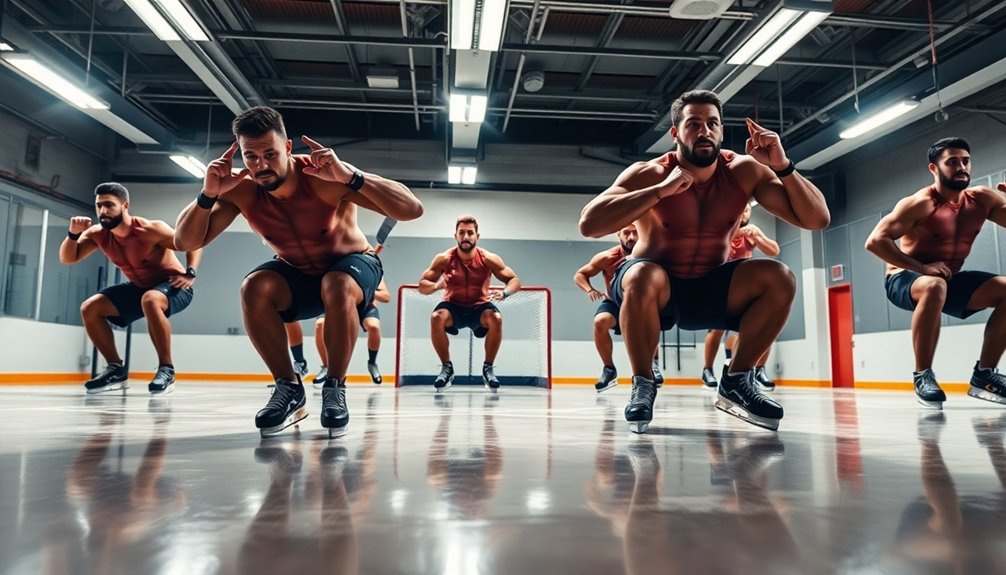
To take your training to the next level, incorporating advanced techniques can greatly amplify your leg strength and performance on the ice. Start with hill sprints; they provide the resistance needed to strengthen your leg muscles while enhancing your cardiovascular fitness, essential for maintaining endurance and speed during games.
Next, add plyometric training to your workout routine. Box jumps and squat jumps enhance explosive leg power, which greatly improves your acceleration and quick starts on the ice.
Don't overlook sled push/pull exercises. These mimic hockey-specific movements, building functional strength and speed that are critical for on-ice performance.
Weighted lunges are another excellent addition; they target multiple muscle groups, boosting your strength, balance, and agility necessary for effective skating.
Finally, integrate core training with your lower body workouts. Exercises like the Pallof press guarantee stability during explosive movements, lowering your risk of injury while maximizing your overall performance.
Recovery Strategies
Recovery is just as essential as training when it comes to building stronger legs for hockey.
You need to incorporate effective recovery strategies to prevent overtraining and promote muscle repair. Here are some key practices to take into account:
- Active Recovery: Engage in low-intensity activities like cycling or swimming to enhance blood flow and reduce muscle soreness.
- Foam Rolling and Stretching: Use foam rollers and perform dynamic stretches post-workout to alleviate tightness and improve flexibility.
- Prioritize Sleep: Aim for 7-9 hours of quality sleep each night to support muscle recovery and hormonal balance.
- Hydrate: Make sure you drink enough water throughout the day, especially post-exercise, to help with recovery.
- Proper Nutrition: Focus on consuming a balanced diet, including adequate protein intake after workouts, to aid muscle repair.
Training Program Resources
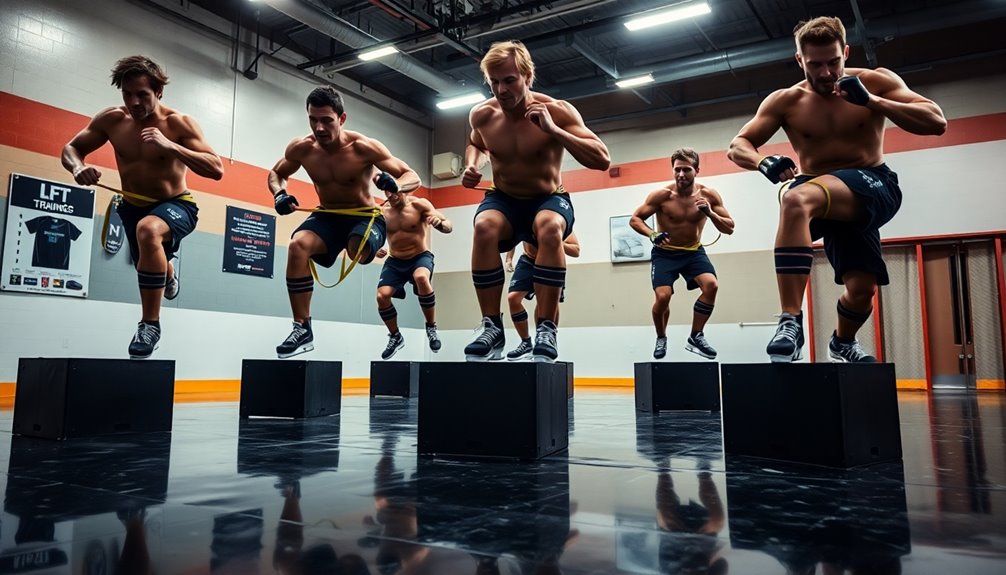
When it comes to building stronger legs for hockey, having access to the right training program resources can make all the difference. The "Next Level Hockey Training 2.0" program offers over 60 weeks of structured off-ice workouts specifically designed to enhance leg strength and power.
Focusing on both off-season and in-season training, this program helps you maximize your on-ice performance.
Trainer Yunus Barisik, CSCS, has successfully trained more than 500 hockey players, including NHL Draft picks. His structured approach emphasizes the effectiveness of targeted training programs for developing leg strength.
You'll find valuable training articles on Next-Level-Athletics.com that explore effective leg exercises, nutritional strategies, and essential recovery techniques.
Utilizing multi-joint movements and progressive overload strategies in your hockey training is key to maximizing strength gains.
These techniques not only help you build power in your legs but also enhance your overall athletic performance on the ice.
Trainer Credentials
Yunus Barisik, CSCS, stands out as a leading expert in hockey performance training, having successfully coached over 500 players, including NHL Draft picks. His impressive trainer credentials not only highlight his extensive experience but also his ability to help hockey players enhance their leg strength and overall performance on the ice.
Barisik's approach integrates innovative methods tailored specifically for hockey athletes.
Here's what makes his training programs exceptional:
- Proven Track Record: Over 500 players trained, including aspiring NHL talent.
- Expert Articles: Authored content for top fitness platforms, showcasing his training methodologies.
- Next Level Resources: Developed "Next Level Hockey Training" to focus on injury prevention and strength gains.
- Structured Workouts: Detailed off-season and in-season training plans designed to maximize leg power.
- Engaging Community: Strong social media presence, sharing insights and success stories for ongoing improvement.
With his expertise, Barisik empowers athletes to reach new heights in their performance.
Community Engagement
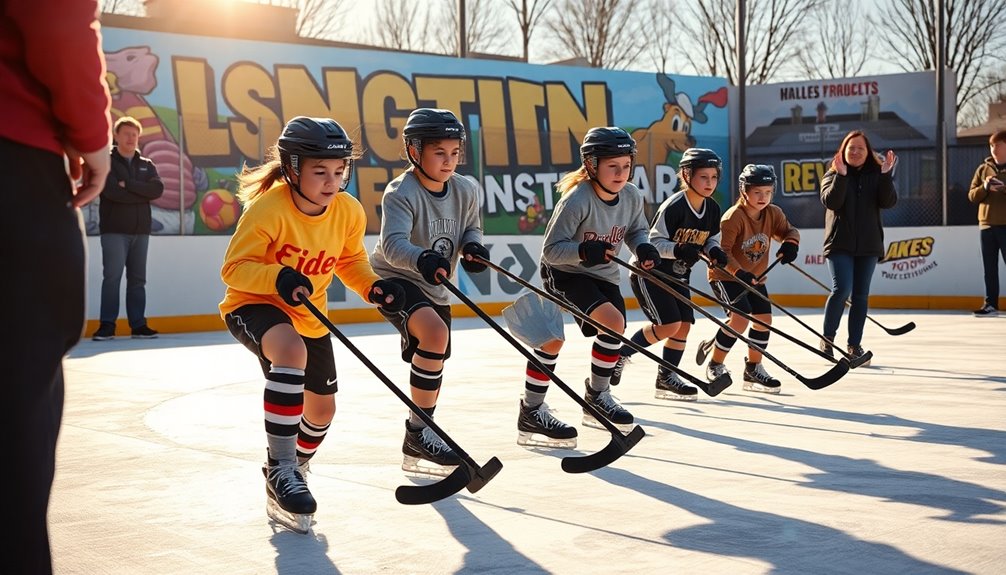
Engaging with the hockey community on social media can greatly boost your training journey.
By following success stories and sharing your own experiences, you'll find motivation and tips from fellow athletes who are also focused on building leg strength.
Platforms like Instagram and YouTube create a space where you can learn from others and improve your performance together.
Social Media Interaction
Social media has become a powerful tool for hockey players to connect and learn from one another, with over 4,000 followers actively participating in discussions about leg strength training. This vibrant community fosters social media interaction, allowing athletes to share valuable training techniques and insights.
Here's how community engagement thrives on these platforms:
- Video Demonstrations: Key leg exercises like squats and lunges are showcased, helping players visualize proper form.
- Regular Updates: Consistent posts keep followers informed about the latest drills and training strategies.
- Challenges and Polls: Engaging activities invite participants to share their experiences and discuss best practices.
- Collaborative Learning: Athletes are encouraged to ask questions, creating a supportive environment for skill improvement.
- Emphasis on Recovery: Content often highlights the importance of recovery, reinforcing its role in performance enhancement.
Athlete Success Stories
Athletes are increasingly sharing their success stories on social media, highlighting how structured leg training programs have transformed their performance on the ice.
You'll find numerous players showcasing their journey, emphasizing how multi-joint exercises like squats and deadlifts have enhanced their leg strength. These workouts develop the explosive power essential for quick skating starts and powerful strides, directly boosting your speed during games.
Through platforms like Instagram and YouTube, players exchange invaluable tips and celebrate each other's progress, fostering a supportive community that encourages everyone to enhance their leg strength.
Consistency is key; many players commit to training 2-3 times a week to achieve ideal results in strength and power.
Success stories often mention tailored training programs designed by experts, such as Yunus Barisik, which have led to significant improvements in their performance metrics. Increased scoring potential and overall agility on the ice are just a few of the benefits reported.
If you engage with these success stories, you'll feel inspired to start your own journey, knowing that with dedication and the right approach, you, too, can elevate your leg strength and speed on the ice.
Off-Season Vs In-Season Training
When it comes to hockey training, understanding the differences between off-season and in-season workouts is vital for maximizing performance.
In the off-season, your focus should be on building strength, power, and endurance through multi-joint exercises. This is the time to target your lower muscle groups and enhance your explosive power.
Consider incorporating these elements into your off-season training:
- Squats and deadlifts for overall strength
- Plyometric exercises for explosive power
- 2-3 workout sessions per week to build endurance
- Core stability exercises to support leg strength
- Flexibility routines to aid recovery
On the other hand, in-season training shifts to corrective exercises and mobility work. This guarantees you maintain strength while preventing fatigue.
Your workouts will be shorter but should still prioritize muscle engagement.
Consistent off-season training leads to improved leg strength and power, which is essential for your on-ice performance.
Plus, focusing on prevention strategies during this time can greatly reduce the risk of injuries when the competitive season kicks off.
Balancing these two phases is key to sustaining your performance throughout the year.
Building a Stronger Foundation
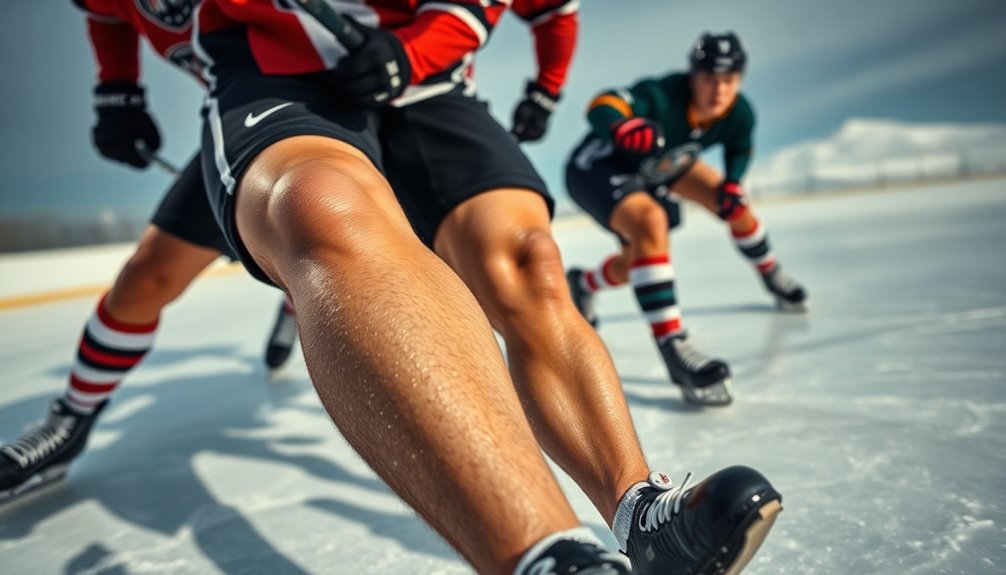
A strong foundation in leg strength is vital for hockey players, as it directly impacts your skating speed, agility, and overall performance on the ice. To develop this foundation, focus on multi-joint leg exercises like squats and deadlifts. Incorporate these into your training routine 2-3 times a week to build explosive power.
Strong quadriceps, hamstrings, and glutes not only enhance your scoring potential but also improve balance and stability during gameplay, which helps reduce injury risks. Aim for consistent leg training, emphasizing progressive overload and proper form. This approach can lead to measurable improvements in your speed, allowing you to increase your sprint speed through targeted workouts.
Additionally, utilizing plyometric exercises such as box jumps and lateral bounds will further enhance your leg strength and explosive power. These exercises are essential for achieving quick starts and powerful strides on the ice, giving you an edge over your competition.
Conclusion
In hockey, strong legs are the key to speed and power on the ice. By prioritizing leg strength and incorporating drills into your training routine, you're setting yourself up for success. Remember, "You reap what you sow." So, whether it's the off-season or in-season, commit to building that solid foundation. Your hard work will pay off when you skate faster, shoot harder, and dominate the game. Keep pushing yourself—greatness is within your reach!


